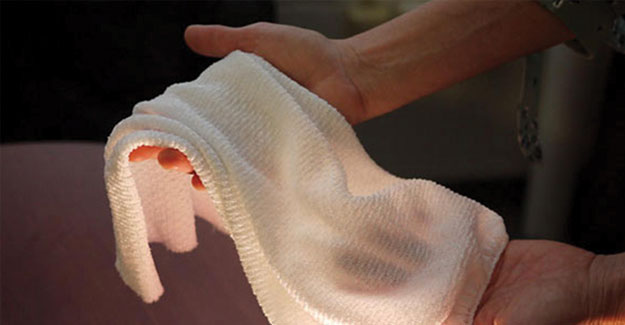
'Cool' Textile Automatically Regulates Amount Of Heat That Passes Through It
Made from specially engineered infrared-sensitive yarn, which responds to changes in the temperature and humidity of a person's skin by dynamically collapsing or expanding the structure of its fibres, the newly-developed textile shows great potential in the development of clothing systems capable of autonomously adapting to demanding environments. The human body absorbs and sheds much of its heat in the form of infrared radiation. Most textiles trap this energy, which keeps us warm in cold weather. However, the development of a material that is able to shed this energy, and thus passively cool the body, has remained a challenge. While other materials have achieved radiative cooling in various forms, through textiles that can reflect sunlight and also allow heat radiating from a person's body to escape, none are responsive to environmental changes or possess the ability to regulate both heating and cooling. "The human body is a perfect radiator. It gives off heat quickly," said co-lead author Professor Min Ouyang, a researcher at the University of Maryland. "For all of history, the only way to regulate the radiator has been to take clothes off or put clothes on. But this fabric is a true bidirectional regulator." The base yarn for the new infrared-adaptive textile is created with fibres made of two different synthetic materials - one absorbs water and the other repels it. The strands are coated with carbon nanotubes, a special class of lightweight, carbon-based, conductive metal. Because materials in the fibres both resist and absorb water, the fibres warp when exposed to humidity such as that surrounding a sweating body. That distortion brings the strands of yarn closer together, which does two things. First, it opens the pores in the textile. This has a small cooling effect because it allows heat to escape. Second, and most importantly, it modifies the electromagnetic coupling between the carbon nanotubes in the coating. "You can think of this coupling effect like the bending of a radio antenna to change the wavelength or frequency it resonates with," said Professor YuHuang Wang, also from the University of Maryland. "It's a very simplified way to think of it, but imagine bringing two antennae close together to regulate the kind of electromagnetic wave they pick up. When the fibres are brought closer together, the radiation they interact with changes. In clothing, that means the fabric interacts with the heat radiating from the human body." Depending on the tuning, the textile either blocks infrared radiation or allows it to pass through. The reaction is almost instant, so before people realise they're getting hot, the garment could already be cooling them down. On the flip side, as a body cools down, the dynamic gating mechanism works in reverse to trap in heat. "The results of testing the material show that the textile was able to alter heat radiation by over 35% as it adjusted to the surrounding relative humidity," the scientists said. "The heat-adapting meta-fibres can be knit, dyed and washed similarly to other performance fabrics and are compatible with current commercial processes."
Textile Excellence
If you wish to Subscribe to Textile Excellence Print Edition, kindly fill in the below form and we shall get back to you with details.








